When pathogens become a living medicine
Last week at the City of Hope National Medical Center in the United States, doctors and scientists began clinical trials of a virus-based cancer therapy. The advanced therapy, called Vacinia, uses a strain of a virus designed to target and attack cancer cells.
Vaccines can also amplify the patient’s own immune response. Since then, it has become a two-in-one approach that is both therapeutic and immune-boosting. If the clinical trial is successful, it is hoped that Vacinia will become the treatment of choice for patients with terminal cancer.
In previous animal experiments, this viral therapy has been shown to be effective against solid colorectal, lung, breast, ovarian and pancreatic tumors.

When the virus becomes a living medicine
When you think of viruses, you picture small, formidable, and infectious creatures. Even then, they’re just zombie creatures, half alive and half dead. It is true, most viruses need to parasitize the host and then they cause illness – mild colds, severe flu like SARS, HIV, Ebola…
Viruses work by invading a host cell, taking over its cellular functions, taking advantage of its nutrients and resources to replicate and release new viral particles. The viruses then multiply exponentially, infecting more cells and causing disease.
But not all viruses are bad. Some viruses can be used by humans to cure diseases. In phage therapy, for example, scientists will use viruses that infect bacteria to treat patients with multidrug-resistant infections.
When the superbugs they were infected with became resistant to all human antibiotics available, phage viruses were their last resort. In 2016, an American doctor named Ali Khodadoust injected 100 million viruses into my chest to cure an infection that persists for 4 years.
In 2018, a 15-year-old British girl with liver and lung infections was also miraculously saved thanks to phage therapy. The little girl got inject billions of viruses into people within 6 weeks and they helped her save her life in the moment of hanging hair.
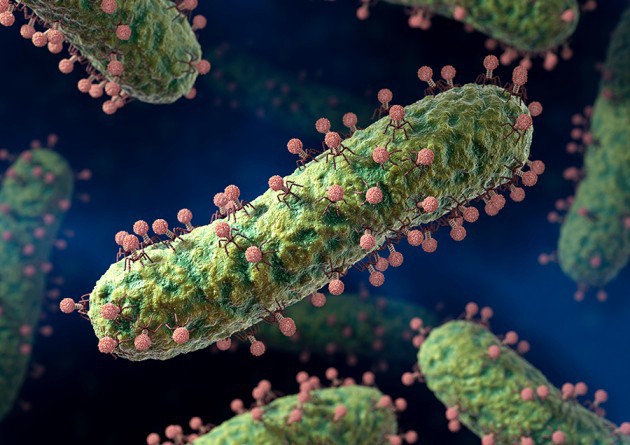
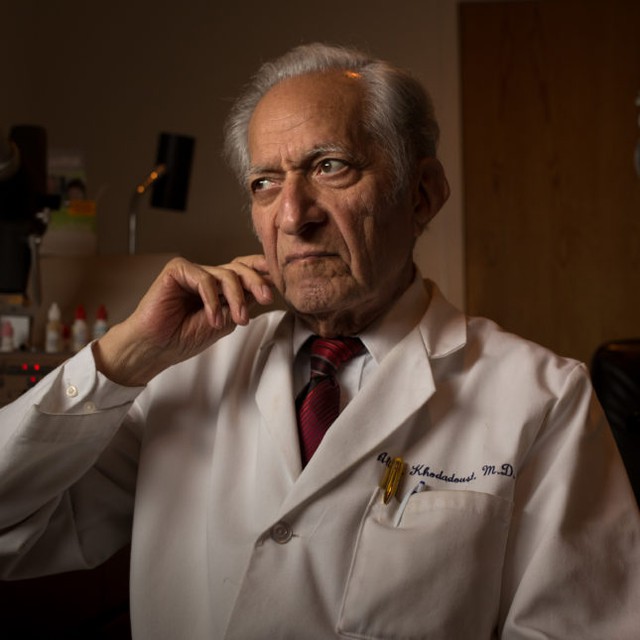
Doctor Ali Khodadoust, who was injected with 100 million viruses into his chest to cure an infection that persisted for 4 years.
Not only curing infections, viruses can sometimes also help us fight against diseases caused by another, more dangerous virus. For example, studies in HIV patients show that people infected with a strain of the virus called Pegachus C (GBV-C) live longer than patients without it.
GBV-C is a benign virus that causes no clinical symptoms. But it can slow HIV growth by hijacking host receptors, competing for HIV to enter cells.
In addition, they promote the release of interferons and cytokines, proteins secreted by white blood cells that trigger an inflammatory response and eliminate invading cells or pathogens.
Working by a similar mechanism, the Herpes virus (the latent form that causes no symptoms) can also help killer cells (a type of white blood cell that occurs naturally in the body) to identify cancerous or cancerous cells. cells infected with other pathogenic viruses.
Viruses equip killer cells with antigens (a foreign substance that can trigger an immune response in the body), allowing them to identify tumor cells.
This is both a competitive strategy and a survival strategy for viruses, helping them to survive longer in the host. Because if you die from cancer or an infectious disease, the viruses will sooner or later die after your body stops working.

This is how viruses help us cure antibiotic-resistant infections.
Viruses can cure cancer
For decades, many scientists have wondered: If viruses can attack cells in the body, can we use them to attack cancer cells directly?
The goal is to create some strains of the virus that only target and kill cancer cells, ignoring or leaving healthy cells alone. This burgeoning field is known as “oncolytic viruses,” or the study of viruses that cure cancer.
The City of Hope National Medical Center in California, USA entered this race with a candidate of theirs known as the CF33-hNIS virus, or Vacinia. The therapy is currently being co-developed with Imugene Limited.
Vacinia was originally a strain of the smallpox virus (CF33) in the family Poxviridae. It was once used as a vaccine against smallpox, one of the most devastating epidemics in human history.
In 1922, scientists first discovered that CF33 has the ability to infect and kill cancer cells. It is also the first “oncolytic virus” to open an era for this area of research.
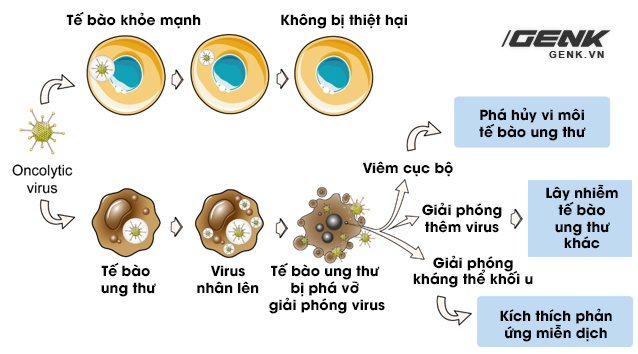
The CF33 virus is a strain of double-stranded DNA virus. It is genetically very stable, has a short life cycle, and spreads rapidly from cell to cell without integrating into the host genome.
To give CF33 more power, researchers at the City of Hope National Medical Center, USA, led by professor Yuman Fong added to it a gene called hNIS (Human Sodium-Iodide Symporter).
This gene helps the virus target cancer cells. According to Imugene, Vacinia has a “resolution” high for cancer, which means that it can simultaneously target many types of tumors, many types of cells of different cancers.
Animal tests have shown that Vacinia has the ability to shrink colon, lung, breast, ovarian and pancreatic tumours. It can kill tumors that are injected with the virus directly, and also those that are out of range that are not injected.
What is more special is that this genetically modified virus not only infects and damages cancer cells, it also exposes these cells to the immune system.
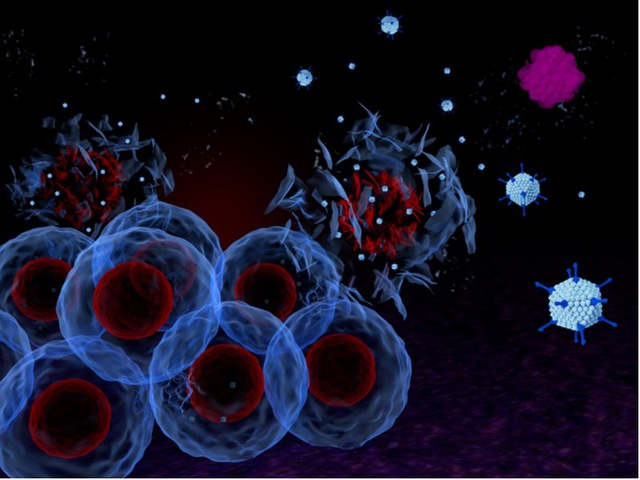
Viruses pave the way for immunotherapy
We know the human immune system has 2 functions. First, it needs to knock down foreign cells that harm the body, pathogens, bacteria and viruses. Second, the immune system must not harm its own cells.
If the immune system attacks the body’s healthy cells, it causes diseases known as autoimmune diseases such as: type 1 diabetes (when immune cells attack pancreatic islet cells), anemia Malignant (when immune cells attack marrow or blood cells), lupus erythematosus causes damage to nearly the entire body…
The problem with cancerous tumors is that they develop from the body’s own cells. So, the immune system doesn’t treat cancer as a foreign disease, they often ignore the cancer to develop.
Recently, scientists are developing immunotherapies called CAR-T, which help the body’s immune cells recognize cancer cells as diseased cells and attack them.
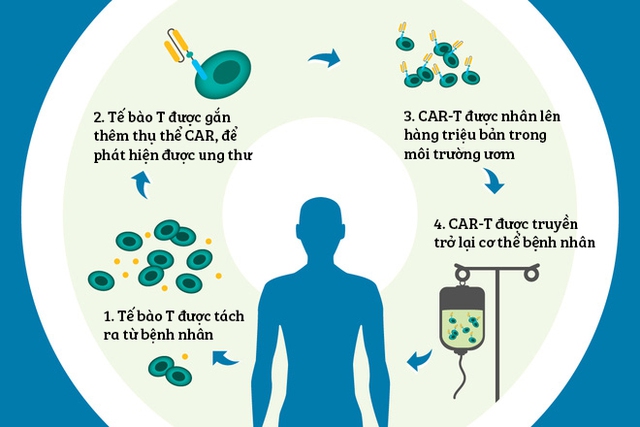
First, doctors will connect the patient’s body to a dialysis machine. The machine automatically filters white blood cells called T cells out of their blood. These cells are stored in a plastic bag, while other blood cells are infused back into the patient’s body.
The technicians then bring a plastic bag containing the T cells back to the lab. There, they will use a benign virus, which infects T cells, to transfer a genetic code into the cell’s genome.
The genetic code from the virus instructs the T cell to grow out of itself a man-made antigen receptor called CAR (chimeric antigen receptor). CAR receptors are like keys on the outside of T cells, they are responsible for finding the right locks on the cancer cell.
Thanks to this, T cells after having CAR will know which diseased cells they need to kill. This CAR-T complex is then incubated by technicians in millions of copies in the laboratory, then packaged into drug bags to be passed on to cancer patients.
In a number of clinical trials and real cases, CAR-T has shown remarkable effectiveness, helping some patients with advanced stage cancer, once considered incurable, to go into complete remission. .

Peter Bjazevich, a patient receiving CAR-T at the Fred Hutchinson Cancer Research Center
However, the weakness of CAR-T is that it requires the CAR immune antigen to be specifically fine-tuned for each different cancer. CARs can only be trained to attack certain cancer cells, just like a key has to open its right lock.
CAR-T has worked very well in patients with blood cancers, but it has proved limited in treating solid tumors, which account for 90% of cancers worldwide.
The nature of this failure, Imugene said, is that the CAR keys cannot open the antibody locks on solid tumor cells. So they and scientists at City of Hope National Medical Center solved this by teaching the CF33-hNIS virus to break into cancer cells and unlock them.
The CF33-hNIS virus is fitted with a gene that expresses the CD19 receptor, once it infects a cancer cell, this gene directs the cell to express CD19 locks, giving CAR-T cells the key. The key against CD-19 recognizes and destroys this cancer cell.
“Now is the time to further enhance the power of immunotherapy, and we believe that CF33-hNIS has the potential to improve outcomes for our patients in the battle with cancer.“, said Associate Professor Daneng Li in the Department of Cancer Research & Medical Therapeutics, City of Hope National Medical Center.
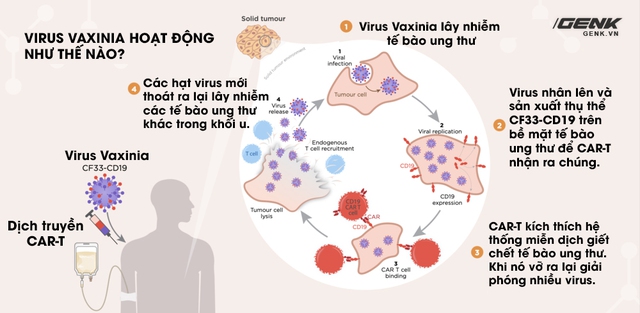
Going back to the ongoing clinical trial of Vacinia, it will be performed on the first 100 patients with metastatic, or growing, solid tumors that cannot be stopped by chemotherapy or radiation.
The patients will be divided into two groups, one will receive Vaxinia alone, the other will be combined with pembrolizumab, an immunotherapy drug with anti-CD-19 receptors to test the ability of Vacinia to guide.
This is a phase I clinical trial, which means it is aimed at testing the safety and optimal dosage of the virus. But will the doctors and scientists at the City of Hope National Medical Center also monitor whether patients respond to Vacinia? Will their cancer go into remission and what is their survival rate for the next few years?
The trial is expected to be completed in early 2025, and scientists at the City of Hope and Imugene National Medical Centers will continuously update their results. Once again, the Vacinia virus is where we put our faith, that a pathogen can also be turned into a living medicine.
Synthetic
at Blogtuan.info – Source: genk.vn – Read the original article here

